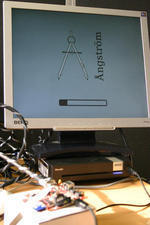Coming to life

Beagleblog
There are several options for running a Linux system on the BeagleBoard. The most common is the Angstrom distribution, alternatives include an Android port by the Embinux company, a custom Ubuntu, and maybe more I don't even know of. I'll go with Angstrom for now, others distributions will have to wait.
The BeagleBoard has a card reader slot that can read SD and SDHC cards, so I am getting an 8GB SDHC card to store the Linux system. Conveniently, you can just prepare the flash card with your Linux PC – provided you have a working card reader.
Installing Angstrom is not a big deal; the only challenge is to partition the SD card appropriately. I just followed the tutorial on http://code.google.com/p/beagleboard/wiki/LinuxBootDiskFormat and everything worked out. According to the tutorial, you need to set some low-level parameters you might know from BIOS settings for your hard drive, such as cylinders and read/write heads (which don't really exist with a flash card). One FAT partition is for booting the system, another Ext3 partition will contain the Linux system.
When you are done partitioning, you need to copy the boot files into the FAT partition and un-tar Angstrom to the Linux filesystem. The web page http://code.google.com/p/beagleboard/wiki/HowToGetAngstromRunning lists the actual commands. I did not need to update the BeagleBoard firmware as the page proposes because it was already up to date on my hardware. So after unpacking the files, you just need to configure the boot loader.
Putting the SD card into the slot on the BeagleBoard and plugging the (USB) power in will immediately show the bootloader screen, followed by the well-known Linux boot messages. If you have a monitor attached to the board via an HDMI/DVI cable, you will see a graphical boot screen, too. Connecting mouse and keyboard via a USB hub will make the BeagleBoard an almost fully functional graphical terminal – you just don't have a network connection.
Subscribe to our Linux Newsletters
Find Linux and Open Source Jobs
Subscribe to our ADMIN Newsletters
Support Our Work
Linux Magazine content is made possible with support from readers like you. Please consider contributing when you’ve found an article to be beneficial.

News
-
Parrot OS Switches to KDE Plasma Desktop
Yet another distro is making the move to the KDE Plasma desktop.
-
TUXEDO Announces Gemini 17
TUXEDO Computers has released the fourth generation of its Gemini laptop with plenty of updates.
-
Two New Distros Adopt Enlightenment
MX Moksha and AV Linux 25 join ranks with Bodhi Linux and embrace the Enlightenment desktop.
-
Solus Linux 4.8 Removes Python 2
Solus Linux 4.8 has been released with the latest Linux kernel, updated desktops, and a key removal.
-
Zorin OS 18 Hits over a Million Downloads
If you doubt Linux isn't gaining popularity, you only have to look at Zorin OS's download numbers.
-
TUXEDO Computers Scraps Snapdragon X1E-Based Laptop
Due to issues with a Snapdragon CPU, TUXEDO Computers has cancelled its plans to release a laptop based on this elite hardware.
-
Debian Unleashes Debian Libre Live
Debian Libre Live keeps your machine free of proprietary software.
-
Valve Announces Pending Release of Steam Machine
Shout it to the heavens: Steam Machine, powered by Linux, is set to arrive in 2026.
-
Happy Birthday, ADMIN Magazine!
ADMIN is celebrating its 15th anniversary with issue #90.
-
Another Linux Malware Discovered
Russian hackers use Hyper-V to hide malware within Linux virtual machines.

